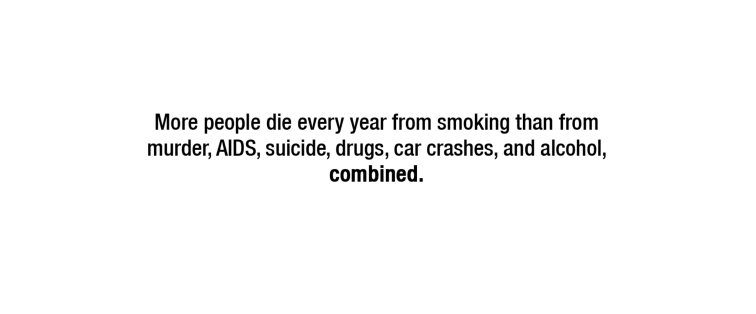The Good and Bad News about Tobacco Company Ads Against Their Own Products

Statements like the image above on the clear harms of cigarettes aren’t new, but starting this week, due to a federal court order a decade in the making, their source may surprise you. Over the next 52 weeks, TV and print advertisements will display statements like these that tobacco companies will entirely fund. The TV advertisements will run on broadcast TV (CBS, ABC, and NBC) during primetime, while full-page newspaper ads will appear in publications in more than 50 major cities through April 2018.
There is both good and bad news that we must consider as we watch the release of these advertisements.
The Good News: Tobacco Companies Funding Advertisements Against Their Harmful Products
I cannot understate how important it is that major U.S. tobacco companies are going to publish and promote the truth about their own deadly and addictive products. These “corrective statements” stem from a lawsuit judgment issued in August 2006, in which a judge ruled that tobacco companies deceived the American people for over 50 years about the health effects of smoking and directly advertised to children. For more than 11 years, tobacco companies tried to delay the release of these statements, but now they must follow through on this court ordered action. That’s the good news.
The Bad News: Billions of Dollars are Still Being Used to Market to Children
Unfortunately, what tobacco companies will pay for these advertisements will be just a drop in the bucket. Tobacco companies still spend billions of dollars - $8.24 billion in 2015, according the Federal Trade Commission - marketing their products in stores, at the point-of-sale, and targeting particular communities, especially children and young adults, to addict the next generation of smokers. Comparatively, they’ll only spend about $50 million on these corrective advertisements. That’s a mere 0.6 percent of tobacco company marketing expenditures.
This is particularly troubling because tobacco industry marketing, advertising, and promotions have been found to encourage youth smoking, increase total cigarette sales, distort youth perceptions about the popularity of smoking, foster addiction, and undermine quit attempts. Further, the additional flavors that the industry has added to cigarettes, particularly menthol, have been shown in numerous studies to encourage youth experimentation, regular use, and ultimately, addiction.
As a pediatrician, I’m also concerned that these court-ordered advertisements are only going to appear on broadcast TV and within newspapers – not on cable TV or digital platforms. This means that these corrective advertisements are unlikely to reach the most vulnerable group – children, adolescents, and young adults – all of whom tend to consume content online or through streaming platforms. While the advertisements are a necessary and delayed step, we should continue to focus on implementing other effective, evidence-based methods for reducing adolescent smoking initiative and addiction.
Restriction of Point-of-Sale Tobacco Advertisements and Bans on Mentholated Tobacco Products Could Work
Preventing adolescent and young adult smoking is a key public health priority considering nearly 10 percent of U.S. adolescents smoke cigarettes, 80 percent of youth who initiate smoking transition to regular use by young adulthood, and more than 90 percent of adult smokers initiate tobacco use before age 18. Recognizing this, the 2009 Family Smoking Prevention & Tobacco Control Act gave state and local governments the authority to enact the following restrictions in order to address public health concerns and protect youth from the harms of tobacco. Two key areas of potential success include point-of-sale tobacco marketing and menthol cigarette policies:
- Point-of-sale tobacco marketing is widespread at retail stores. Tobacco retailers near schools place more tobacco marketing materials near products for children, such as candy, than tobacco retailers in other locations. Restrictions on placement of tobacco products to protect children have had success internationally, but policies affecting advertising and promotions face unique legal challenges in the U.S. However, by targeting tobacco flavoring, Philadelphia and other localities have pioneered efforts to reduce potential tobacco marketing to children.
- Menthol cigarettes are disproportionally used by young smokers, and the menthol in cigarettes makes them more attractive to children, easier to smoke, and more likely to result in addiction. Local governments, including San Francisco and Oakland, have banned the sale of menthol tobacco products to protect children and adolescents. Philadelphia also has a number of new efforts to protect children and adults from the damaging health effects of these products.
Here at PolicyLab, we’re looking for solutions to help not only our patients quit smoking, but also their parents. By helping parents quit smoking, we can improve the child’s health and prevent them from becoming smokers in the future. We’re also applying behavioral economics principles, such as message framing that leverages loss aversion, to motivate parents to engage in treatment.
We’ll need more evaluation on other effective policies, but in the meantime, we can all help ensure the success of these interventions by continuing to focus on efforts to protect children from the harms of tobacco – the leading preventable cause of disease and death in the U.S.
Interested in issues of tobacco use by teens and parents? Check back in to our website on December 12th for a new webinar on what primary care pediatricians needs to know about e-cigarette use.

